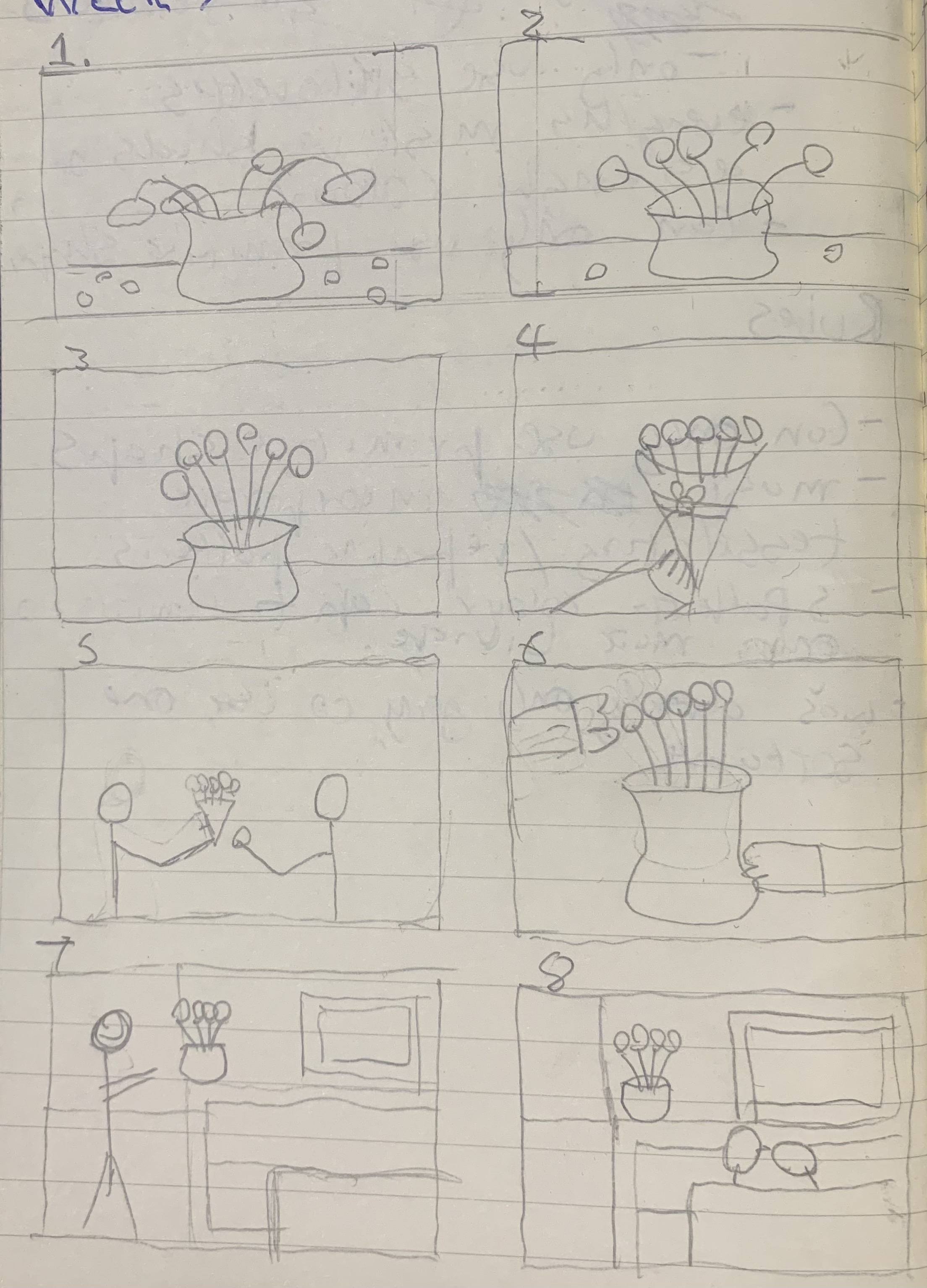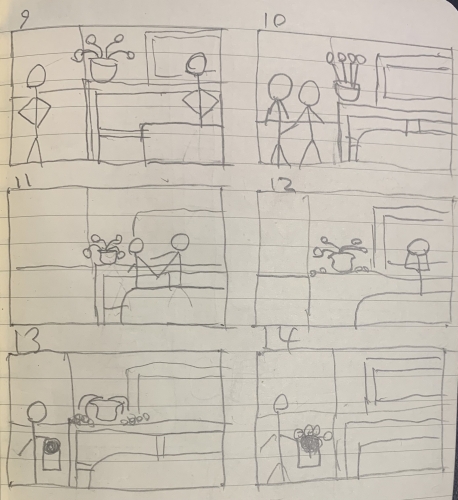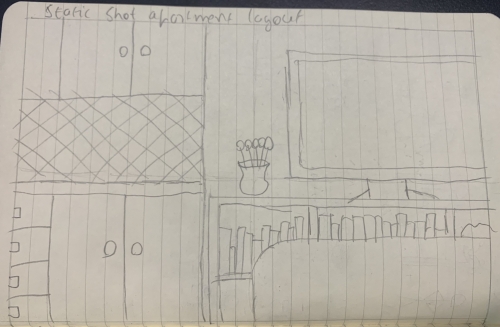
When thinking about time in stories I’m immediately drawn to examples where time is nonlinear or malleable in some way. The premise I contributed to the premise exercise was ‘A vase full of wilted flowers sits on a mantlepiece, surrounded by fallen petals. The petals begin to float back to the flowers, re-attaching themselves. The flower stems begin to straighten and stand tall, with colour seeping back into the blooms. A young man approaches, picking up the bundle of flowers and inhaling their scent, sighing happily’. I packed a lot into the premise but don’t think I really captured the idea I was going for. I was drawn to the imagery of the flowers going from wilted to full bloom, but wasn’t sure how to convey what I wanted this to mean. In her feedback on the premises, Susan asked if the man was controlling the flow time, or if the premise was about love, which did get me thinking.
I decided that I wanted to develop the concept for an animated piece this week, and tell a story about two men as their romantic relationship deteriorates. Having decided on this, I then bullet pointed the action as it would be shown to the viewer (I initially did this as a mind map, with additional thoughts/notes in bubbles adjacent to the sequence of events, but since it was mostly the one list of events the mind map felt superfluous for this exercise)
- Opens with the shot described in the premise, time moving backwards and showing a bouquet of flowers transforming from dead, to wilted, to fresh and vibrant.
- The camera is then pulled back from the bouquet, and we see one man gift the flowers to another, who places them in a vase of water and places them on the mantelpiece (centre of the frame).
- The animation begins to move backwards and forwards through time, showing snippets of the couple as they alternate between domestic bliss and turbulence. (The camera will remain static in this position for the rest of the animation. The state of the flowers on the mantelpiece helps indicate the moment in time, and the state of the relationship; fresh when the relationship is happy and wilting when the relationship is rocky)
- Sitting together on the couch, watching TV
- Standing across the apartment from each other, arguing
- Cooking together, one with his arms wrapped around the other’s waist
- One pushing the other away as they try to embrace them
- Lingers on a shot of the apartment owner (the one who was given the flowers) crying on the couch.
- The piece ends with the man cleaning his apartment. He picks up the vase of flowers and empties them into the trash.
Because this was intended to be a piece of animation, I decided to try storyboarding the action. I haven’t done storyboarding since Week 1, because I dislike doing them, and have found that other pre production methods come a bit more naturally to me.. I’m not very good at drawing, and even though I know that ‘good’ drawings aren’t the point of storyboarding, my lack of skill makes them frustrating to do, and I never feel like I’m getting my ideas across well visually.
I decided to hand draw the storyboards, just in my notebook, rather than having to use a drawing tablet and wrestle with drawing softwares (and I also did them in a small size, so I guess they might technically be thumbnails rather than storyboards?). I followed the sequence of events as I’d described them in my dot points, but found myself wondering what the point of telling the story in this nonlinear manner was. I decided that what the story needed was a little bit extra at the beginning. Rather than starting off with the sequence of the bouquet un-wilting, it should start off with the man cleaning his apartment, and picking up the vase full of dead roses, which then shifts into the flower revival sequence. This bookends the piece a little bit better, and re-contextualises the jumps in time as memories being recalled by the character, so I think storyboarding to visualise the sequence of events was really beneficial, even though I still dislike the process.
The ideas that I’m exploring with this exercise are the loss of love, the messy ends of relationships; and the way that physical spaces and objects can contain memories that are both pleasant and unpleasant for the rememberer. I think the piece would be suited to the medium of animation because of its ability to show metamorphosis and transitions. I also think it would be interesting to have the static apartment shots show the changes in time not through cuts, but the shifting of colours, with human characters wavering in and out of existence as the memories change.
My main inspiration for this week's exercise is the film (500) Days of Summer, which was directed by Marc Webb and released in 2008 (trailer viewable here), which similarly explores the failings of a romantic relationship in a non-linear format. The film is centred on the character Tom, and explores his relationship with his love interest Summer. The film jumps backwards and forwards through their 500 day long relationship; often juxtaposing Tom’s happiness at the beginning of the courtship with the desolate days he experiences after Summer leaves him, for humorous effect.The film is ultimately about how by projecting all of his romantic feelings onto her, Tom doesn’t really see or treat Summer as her own person, which leads to their breakup, and it's only after Tom comes to terms with this that he is able to look back and recognize the problems present in the relationship.
Another inspiration is the comic ‘Here’, by Richard McGuire, which was first published in volume 2 of RAW magazine, in 1989 (viewable online here) . The comic is an exploration of space over time. The view shown in the panels remains anchored in one position, showing the corner of a room. Each panel shows a different time period, ranging from the distant past before the house was constructed, to the future after the house is destroyed in a fire. The panels overlap each other, juxtaposing the different residents of the home, with their different room layouts and home decor tastes, and the different types of activities they engage in, all of which changes the nature of the space.


